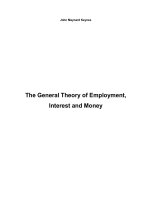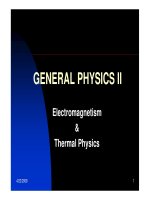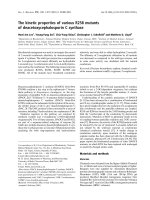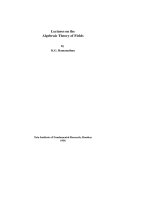Lecture 8 the kinetic theory of gases
Bạn đang xem bản rút gọn của tài liệu. Xem và tải ngay bản đầy đủ của tài liệu tại đây (510.88 KB, 19 trang )
CHAPTER 21 THE KINETIC THEORY OF
GASES – THE FIRST LAW OF
THERMODYNAMICS
The kinetic theory of Gases
1. The number of molecules in the gas is large, and the average separation
between them is large compared with their dimensions. In other words,
the molecules occupy a negligible volume in the container. We model the molecules
as particles.
2. The molecules obey Newton’s laws of motion, but as a whole they move
randomly. By “randomly,” we mean that any molecule can move in any
direction with any speed.
3. The molecules interact only by short-range forces during elastic collisions.
That is consistent with the ideal gas model, in which the molecules exert no
long-range forces on each other.
4. The molecules make elastic collisions with the walls. These collisions lead
to the macroscopic pressure on the walls of the container.
5. The gas under consideration is a pure substance; that is, all molecules are
identical.
KINETIC THEORY
The pressure that a gas exerts is caused by the
collisions of its molecules with the walls of the
container.
We try to derive the equation that relates
the macroscopic quantity P and the
microscopic quantity of the gas – the
average Translational Kinetic Energy
2
P no
3
Pressure (N/m2)
particle density (m^-3)
Average Translational
Kinetic Energy of 1
particle
4
KINETIC THEORY
Consider a collection of N molecules of an
ideal gas in a container of volume V=L3.
Consider molecule i of mass m, velocity vi, It
collides the wall.
The impulse – momentum
theorem gives
mv'i mvi Fwall particle .
2mv xi
Fwall particle
ex
L
v’
v
x
2L
v xi
mv2xi
Fwall particle
ex
L
2
P no
3
Pressure
(N/m2)
mv'i mvi Fwall particle .
2mv xi
Fwall particle
ex
2L
v xi
mv 2xi
Fwall particle
ex
L
mv 2xi
Fparticle wall Fwall particle
ex
L
mv 2xi
m
Fparticle wall L N L v 2x ex
i
v2
3
Nm v 2
Fparticle wall L 3 ex
Fparticle wall
2 N mv 2
P
2
3 L3 2
L
2
P no
3
N
mv 2
no 3 ;
2
L
v 2x
particle density (m^-3)
Average Translational
Kinetic Energy of 1
particle
v 2y
v 2z
Temperature is a direct measure of
average molecular translational kinetic
energy.
2
P no
3
nRT nN A k BT
P
n o k BT
V
V
3
k BT
2
Theorem of equipartition of energy
The average translational kinetic energy per molecule is
1 2 1 2 1 2 1 2 3
m v m v x m v y m v z k BT
2
2
2
2
2
Translational motion has 3 degree of freedom
Each degree of freedom contributes ½ kBT to the energy
of a system
It is also right for degrees freedom associated translatioal,
rotation, and vibration of molecules.
Degree of Freedom i
Monoatomic Gas :i transl. 3
Diatomic Gas : i transl. 3; i rotation. 2; i oscillation. 1
Manyatomic Gas :i transl. 3; i rotation. 3; i oscillation. 3N 6
Internal Energy
Internal energy number of particle energy of 1 particle
i
U N k BT
2
N nN A
n : number of mol
R N A k B :Universal Gas Const
i
i
U nN A k BT nRT
2
2
i
U nRT
2
Equation of state for an ideal gas
PV=nRT
R is called the universal gas constant R=8.31 J/(mol.K)
P pressure is expressed in pascals (1 Pa = 1 N/m2)
V volume in cubic meters
PV has units of joules
20.5 The First Law of Thermodynamics
• The first law of thermodynamics states that when a
system undergoes a change from one state to another,
the change in its internal energy is
U Q W
• where Q is the energy transferred into the system by heat
and W is the work done on the system.
• Although Q and W both depend on the path taken from
the initial state to the final state, the quantity U does not
depend on the path.
Work done on the system
dW F.d s P.S.dy PdV
V2
W PdV
V1
Appications of the 1rst Law of TD
Isothermal process of an Ideal Gas
T const : PV const
U Q W
U 0
V2
nRT
V2
W PdV
dV nRT ln
V
V1
V1
V2
Q W nRT ln
V1
isobaric process P=const
P const : V / T const
U Q W
W PdV PV nRT
U Q PV
i
i2
Q U PV nRT nRT n
RT
2
2
Q nC p T
i2
Cp
R
2
isovolumetric process V=const
V const :
U Q W
W PdV 0
i
U Q n RT nC V T
2
i
CV R
2
Adiabatic process Q=0
U Q W
Q0
i
U W nRT
2
PV const
PV
const
T
1
TV
const
1
T P const
The molar specific heat at constant volume :
CV
The molar specific heat at constant pressure
Cp
The ratio of specific heats
R
1
R
CP
1
CP CV R
CV
CP i 2
CV
i
i
R
2
i2
R
2
ADIABATIC PROCESS
dU Q PdV
Adiabatic process : Q 0
dU PdV
i
dU nRdT
2
PV nRT
PdV VdP nRdT
i
i
dU nRdT (PdV VdP)
2
2
i
(PdV VdP) PdV
2
i2
i
PdV VdP 0
2
2
i 2 dV dP
0
i V
P
ln V ln P ln C
PV Const
PV const
TV 1 const
PV
1
const T P const
T
SUMMARY









